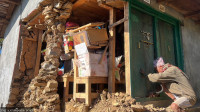Opinion
Visual pollution
Kathmandu and Lalitpur’s billboards are a public safety threat; they need regular inspection
Sophia K Tamot
The gusto with which Kathmandu rose to the challenge of making itself presentable in the run-up to the Saarc Summit went down just as quickly once it was time for the dignitaries to leave. It has been six months hence and the solar-powered street lamps have already stopped functioning. Plants and trees have dried up and are dying while the fresh paint is beginning to peel off walls. Even the zebra crossings are beginning to fade and the cat’s eyes have ceased to blink. Ok, let me admit that this is a slight exaggeration, as not everything has stopped working.
An aesthetic nightmare
Surely, you must have noticed that Kathmandu city has been relatively free of big hoarding boards that carry commercial messages for some time now. I say relatively because I notice that a few seem to crop up every now and then: on the sides of overhead bridges and on buildings that house businesses, for example.
The metropolitan city’s objective is to do away with print adverts on billboards that are not biodegradable, cost time and money to put up and pull apart and visually pollute, and in its stead, have standard electronic displays with interchangeable content that is expected to be less of an eyesore. By embracing technology and going paperless, the municipality hopes the move will help the environment as well as set standard measures for the industry and in the process, make their role as regulators more efficient.
As it is, Kathmandu’s concrete jungle is highly prone to fatal incidents. That by itself is another topic for discussion, but thanks to its skyline of narrow and crooked buildings, the city is already an aesthetic nightmare. Compact apartments are stacked on top of each other in such a way that it feels as if they are competing for vertical space. So minus the boards, the slightly less crowded landscape offers a welcome respite to tired eyes navigating Kathmandu’s traffic, another nightmare of the city.
Just until a few weeks ago, that pleasant surprise was short lived once you crossed over the smelly Bagmati to its sister city, Lalitpur. However, after almost a year of non-compliance, Lalitpur has now followed Kathmandu’s footsteps and removed the huge billboards that were cramping its skyline. With the billboards now gone, it has brought along a sort of aesthetic relief to the public, but what is even more worrying is the haphazard placing of signage and other billboards on private property, which is a growing public security hazard.
A not-so-safe city
As the city grows, crowds keep getting bigger, buildings taller, with swelling piles of spaghetti-like transmission wires, telephone, and television cables. And with these, you see more and more advertisements on hoarding boards of all sizes—on rooftops, walls, street lamps, and even on windows—ad gurus and marketing guys of big corporates haven’t left empty any nook and corner where a billboard can fit and be seen.And so has ad-hoc signage posted by shops and companies all clamouring for visibility. With each passing year, this chaos has been growing, randomly, with no sense of safety or no regulation to adhere to.
Recently, as a bystander across the street, I was witness to a mishap that almost maimed a person standing on the pavement right below a building. A recent storm had left a billboard dangling dangerously from the fifth floor of a building supported by—and what looked like—a single hinge. People below were milling about, minding their own business, all oblivious to the imminent danger above their heads. As the hinge gave way and the board came crashing down, it was only by a few inches that it missed a young woman below. The girl was in obvious shock and did not even let out a scream. Instead, she scurried past, carefully walking under the shaded roof of the building and avoiding the pavement altogether.
Before it’s too late
In the case above, it was pure luck that an accident was averted. But the next pedestrian might not be so lucky. Public safety is one of the topmost priorities of every mayor or municipal office. But it is astonishing to see the lack of adequate monitoring and oversight that goes in the planning and implementation stage from a safety perspective, therefore questioning the way the entire billboard installation business has been allowed to operate, unregulated, for years. Who should take the responsibility? Buildings that make money by renting out their spaces? Or companies whose adverts the billboards are screaming? Or ad agencies that broker all this? Or the municipality itself?
Once the road expansion drive is complete and new pavements built, Kathmandu will see its share of billboards return in a new avatar—in electronic display boards—at least that’s what we have been told to expect. Lalitpur will also be expected to follow suit. However, in the interest of public safety and security in urban areas, both the Lalitpur and Kathmandu city offices will be doing their citizens as well as themselves a great favour if they immediately started inspecting all signage and boards on display and have the poorly installed boards removed at the earliest. As often, let us not wait for disaster to strike to compel us to act, for then it will be too little too late.




 7.12°C Kathmandu
7.12°C Kathmandu










